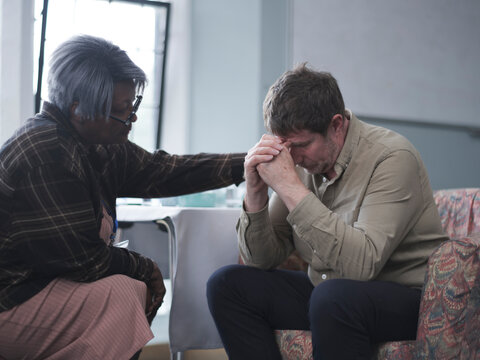For some, the mere thought of a train ride can cause overwhelming panic and distress. The racing heart, the shortness of breath, the feeling of being trapped can be unbearable. However, there is hope for those who suffer from this phobia. In this blog post, we will take you on a journey to recovery through counselling for the phobia of trains. Discover how counselling can help individuals overcome their fears and regain control over their lives. Join us on this transformative journey towards healing and liberation from fear.
What is a Phobia of Trains? Understanding the Fear
Phobia of trains is a specific type of anxiety disorder that can cause intense fear and panic in individuals who suffer from it. This fear can be triggered by the mere thought of trains or even by seeing pictures or videos of them. The fear can be so severe that it interferes with daily life, making it difficult for individuals to travel or even think about traveling by train.
The causes of phobia of trains can vary, but it is often linked to past traumatic experiences or negative associations with trains. Some individuals may also develop the phobia due to a lack of exposure to trains during childhood. Symptoms of phobia of trains can include sweating, trembling, rapid heartbeat, and avoidance behavior. It is important for individuals who experience these symptoms to seek professional help in order to overcome their fear and improve their quality of life.
The Importance of Seeking Counselling for Phobias
Phobia of trains can be a debilitating fear that affects many aspects of someone’s life, from travel to social events. It is important to seek counselling for phobias, as avoiding the problem can lead to further anxiety and even more significant mental health issues. Counselling provides a safe environment where individuals can explore their fears with the support of an expert who understands their struggles. The process involves identifying deep-seated thought patterns and beliefs that contribute to the fear response, as well as developing practical strategies for managing symptoms. With counselling, people learn valuable coping skills that help them face their fears in a controlled manner. This approach empowers individuals with confidence and resilience needed to navigate through difficult situations when they arise in everyday life.
How Counselling Works: Techniques and Approaches to Overcoming Trains Phobia
Counselling for phobia of trains typically involves the use of cognitive-behavioral therapy (CBT) and exposure therapy. CBT helps individuals identify negative thought patterns that contribute to their fear and replace them with more positive, realistic ones. This can include teaching relaxation techniques, such as deep breathing or mindfulness exercises, to help manage anxiety symptoms.
Exposure therapy involves gradually exposing the individual to increasingly challenging situations involving trains in a safe and controlled environment until they are able to face their fears without experiencing panic or distress. This may involve looking at pictures of trains first before gradually moving on to visiting train stations or eventually taking short rides.
Other approaches used in counselling may include hypnosis, virtual reality exposure therapy, and eye movement desensitization and reprocessing (EMDR). The effectiveness of these methods depends on individual needs and preferences. With continued effort over time through regular counseling sessions, individuals suffering from phobias of trains can achieve significant improvement toward overcoming their fears.
Personal Experience: One Person’s Journey to Recovery from Their Fear of Trains
Overcoming the Fear: The First Step to Recovery
To overcome a phobia of trains, the first step is acknowledging that this fear exists and seeking help. It can be tough, but speaking with someone who understands your anxiety will give you a better chance to conquer it. A qualified counselor will use various techniques to treat specific phobias such as Cognitive Behavioral Therapy (CBT) and exposure therapy. These methods often involve gradual steps that enable patients dealing with train phobia to face their fears in a controlled environment, thereby helping them deal with undue stress or anxiety. While therapy takes time, overcoming one’s fear of trains is perfectly achievable through commitment and hard work put forth in each session.
Understanding the Root Cause of Phobia of Trains
For many people, a fear of trains can be traced back to a specific traumatic event in their life such as being involved in an accident or witnessing one. For others, it may be a result of indirect experiences such as hearing about accidents on the news or through stories from others. It is also possible for phobias to develop without any clear trigger.
The key here is identifying and understanding what triggers the anxiety response and how it relates to train travel. With proper counselling techniques, individuals with phobias can learn coping strategies to overcome their fears and regain control over their lives.
Personal Experience: My Journey Through Counselling for Phobia of Trains
I suffered from a severe phobia of trains for years, which made it difficult for me to travel and limited my job opportunities. I finally decided to seek help and went through counselling for phobia of trains. It was a challenging but rewarding experience. My therapist used various techniques such as exposure therapy and cognitive-behavioral therapy to help me overcome my fear. Through gradual steps, I was able to confront my fear and eventually travel on trains without experiencing panic attacks. Counselling not only helped me overcome my phobia but also improved my overall mental health and well-being.
Techniques and Strategies Learned in Counselling for Coping with Triggering Situations
During counselling, I learned techniques and strategies that allowed me to cope with triggering situations related to my phobia of trains. One key strategy was mindfulness, which helped me stay present in the moment and focus on my breathing when anxiety arose. Another important technique was positive self-talk, which involved challenging negative thoughts about train travel and replacing them with more realistic, positive ones. Both mindfulness and positive self-talk were crucial in helping me manage my fear of trains and prevent it from spiraling out of control during trigger situations.

Cognitive Behavioral Therapy (CBT): A Proven Method for Treating Specific Phobias
Cognitive Behavioral Therapy (CBT) is a widely used approach for treating specific phobias, including the fear of trains. This therapy helps individuals change their negative thought patterns and beliefs about trains by challenging them with rational thinking. CBT involves identifying triggers that lead to anxiety and then working through gradually exposing oneself to these triggers in a controlled environment. A therapist may use techniques such as relaxation training, guided imagery, or cognitive restructuring to help clients cope with their fears.
Studies have shown that CBT can significantly reduce symptoms associated with phobias of different kinds, including the fear of trains. Regular sessions with a trained therapist over several weeks or months has proven effective in overcoming train phobia and other specific anxieties. By learning how to face their fears head-on using CBT methods, individuals gain greater control over their thoughts and behaviors during times when they might otherwise feel out-of-control or overwhelmed by fear.

Exposure Therapy and Desensitization: Gradual Steps toward Train Travel Comfort
Understanding Exposure Therapy and Desensitization
Exposure therapy and desensitization are two techniques commonly used in counselling to treat phobias, including the phobia of trains. Exposure therapy involves gradually exposing the individual to the object or situation they fear, while desensitization aims to reduce the emotional response associated with that fear.
In the case of train phobia, exposure therapy may involve looking at pictures of trains, watching videos of trains passing by, or standing near a train station. As the individual becomes more comfortable with each step, they can progress to more challenging exposures such as boarding a stationary train or taking short trips on a train. Through repeated exposure and gradual desensitization, individuals can learn to manage their anxiety and overcome their fear of trains.
Gradual Steps towards Overcoming the Fear of Trains
Exposure therapy is an effective way to overcome a phobia of trains. It involves gradually exposing oneself to train-related stimuli, beginning with less threatening situations and gradually progressing toward more challenging ones. In vivo exposure is conducted in real-life scenarios such as approaching a stationary train or entering a carriage while imaginal exposure can involve describing vividly any anxiety-provoking thoughts related to trains.
Desensitization may involve watching videos that depict scenes on trains incrementally starting from calm scenes before slowly escalating into more intense visuals. This approach helps to change one’s emotional response by rewiring the brain not to perceive trains as dangerous but rather as safe and ordinary modes of transportation. With consistent practice, one can eventually travel comfortably on a train without experiencing debilitating levels of fear and anxiety.
Techniques Used in Exposure Therapy for Phobia of Trains
Exposure therapy is a technique used in counselling to help individuals overcome their phobia of trains. The goal is to gradually expose the person to the feared object or situation, in this case, trains, in a safe and controlled environment. This exposure helps the person become desensitized to the fear and anxiety associated with trains. Exposure therapy can be done through virtual reality simulations or in-person exposure. The therapist will work with the individual to create a hierarchy of train-related situations, starting with the least anxiety-provoking and gradually moving up to more challenging scenarios. With repeated exposure, the person can learn to manage their fear and eventually feel comfortable traveling by train.
Benefits of Exposure Therapy and Desensitization for Train Travel Comfort
Exposure therapy and desensitization are powerful techniques that can help individuals with phobia of trains gradually overcome their fears. These methods involve exposing the individual to progressively more challenging train-related situations, allowing them to become acclimatized to triggers that once caused intense anxiety. By repeatedly confronting and ultimately tolerating these stimuli, individuals can learn new associations with train travel and break down negative thought patterns relating to it. This process allows for increased confidence in managing distressing physical sensations such as rapid heart rate or panic attacks while on trains, resulting in an overall decrease of fear and an increased sense of control over their lives.

Coping Strategies to Manage Anxiety during Train Travel
Anxiety management is a vital aspect of overcoming phobia of trains and preventing relapse. There are several coping strategies that can help individuals manage anxiety during train travel. Deep breathing exercises, progressive muscle relaxation, and visualization techniques can all be effective in reducing anxiety levels. It’s also important to focus on positive self-talk and challenge any negative thoughts related to train travel. Practicing mindfulness techniques such as meditation or yoga can promote overall well-being and reduce stress levels.
Distraction techniques like listening to music or engaging in a conversation with a friend can help shift attention away from anxious thoughts about the journey ahead. Additionally, carrying comforting items like a favorite book, blanket or stuffed animal may provide comfort during the journey.
Taking control of the situation by booking seats near exits or windows may also help ease feelings of claustrophobia associated with train travel. Seeking support from family members or friends who understand your phobia and encourage you throughout the recovery process is an important step towards maintaining progress beyond therapy sessions.
Life after Recovery: Maintaining Progress and Preventing Relapse
Maintaining progress after recovery from phobia of trains is crucial to prevent relapse. It’s essential to continue practicing the coping strategies and techniques learned during counseling, such as deep breathing exercises or visualization techniques.
It’s also important to recognize and avoid triggers that may lead to anxiety. For example, if crowded train stations cause discomfort, it may be helpful to plan travel outside peak hours or consider taking a less busy route.
Additionally, continuing regular sessions with a therapist can provide ongoing support and guidance in managing any residual fears or anxieties related to train travel.
Incorporating lifestyle changes like exercise, healthy eating habits, stress management techniques will help maintain overall mental health and reduce susceptibility to phobias.
Remembering how far one has come in overcoming their fear of trains can serve as motivation for continued growth and self-improvement. Celebrate small victories along the way towards long-term success!
In conclusion, a phobia of trains can be a debilitating fear that can significantly impact an individual’s daily life. Seeking counselling for this phobia is crucial to overcoming it and living a more fulfilling life. Counselling offers various techniques and approaches, such as cognitive-behavioral therapy and exposure therapy, that have proven to be effective in treating specific phobias. Coping strategies can also help manage anxiety during train travel. Recovery from a phobia of trains is possible, and maintaining progress is key to preventing relapse. With the right support and guidance, individuals can embark on a journey to recovery and conquer their fear of trains.
FAQs
Question: Who can develop a phobia of trains?
Answer: Anyone who has had a traumatic experience on a train.
Question: What are the symptoms of a phobia of trains?
Answer: Sweating, shaking, and a rapid heartbeat are common symptoms.
Question: How can I overcome my phobia of trains?
Answer: Treatment options include therapy and exposure therapy.
Question: What is exposure therapy for a phobia of trains?
Answer: Exposure therapy gradually exposes you to trains until fear subsides.
Question: How long does it take to treat a phobia of trains?
Answer: Treatment duration varies based on individual circumstances.
Question: What if therapy doesn’t work for my phobia of trains?
Answer: Other treatment options include medication or hypnotherapy.
